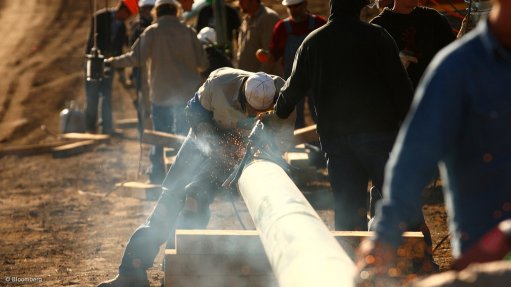
Photo by: Bloomberg
TORONTO (miningweekly.com) – Canada’s number-two pipeline operator TransCanada Corp has cancelled plans to build a marine terminal and oil tank farm at Cacouna, in Quebec, owing to strong local opposition in favour of protecting the St Lawrence Estuary habitat of a population of threatened beluga whales.
The result would be to push back the earliest date at which the pipeline could deliver oil to Eastern Canada by two years to 2020.
TSX- and NYSE-listed TransCanada on Thursday said it had taken the decision to alter the scope of the $12-billion Energy East pipeline project as part of its continued commitment to stakeholder consultation, environmental stewardship and community safety.
“This decision is the result of the recommended change in status of the beluga whales to endangered and ongoing discussions we have had with communities and key stakeholders," TransCanada president and CEO Russ Girling said.
The pipeline infrastructure operator said it was reviewing potential alternative terminal options in Quebec, but stressed that Quebec and New Brunswick refineries would continue to be connected directly to the Energy East pipeline.
TransCanada added that it would move forward the date by which it would submit its emergency response plans for the project, which were typically finalised and provided to the National Energy Board (NEB) in the latter part of the regulatory process.
In the wake of a recent spate of rail accidents involving oil tanker cars, the Energy East project represented an opportunity to establish a reliable supply of mainly Western Canadian crude oil from the Alberta oil patch to refineries in Quebec and New Brunswick.
TransCanada said it would advise the NEB of the outcome of its evaluation of alternative marine terminal sites by the fourth quarter.
The 1.1-million barrels per day Energy East project had secured about one-million barrels per day of firm, long-term contracts. The 4 600-km pipeline project was an important element of TransCanada's $46-billion of commercially secured growth projects.
While the exact route would only be determined after public and regulatory review, the planned starting point was a new tank terminal in Hardisty, Alberta. Three other new terminals would be built along the pipeline’s route, including one in Saskatchewan, one in the Quebec City area and another in the Saint John, New Brunswick, area.
The terminals in the Quebec City and Saint John areas would include marine tanker loading facilities. The project would also deliver oil to existing Quebec and New Brunswick refineries.
The Energy East pipeline project involved three significant components. Energy East would convert an existing natural gas pipeline to oil service between Burstall, Saskatchewan and Cornwall, Ontario. New sections of pipe would also need to be constructed in Alberta, Saskatchewan, Manitoba, Eastern Ontario, Quebec and New Brunswick to link up with the newly converted pipe.
The project would also require associated facilities such as pump stations, tank terminals and marine facilities in order to successfully move the crude oil from Alberta to New Brunswick, and access new markets.